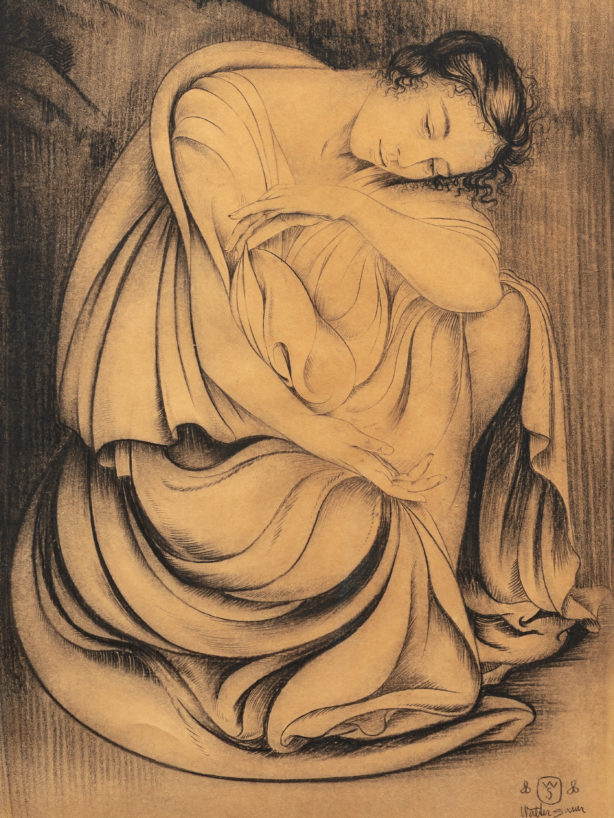Serenity
This drawing by Walter Sauer, datable to around 1920, perfectly illustrates the essence of his art. While the figure of the modern, free, and emancipated woman of whom he is a true poet, runs throughout his work, here he offers a singular variation. The depicted woman, whose face exudes modernity, is enveloped in a flowing drapery whose supple lines echo those of the landscape in the background. This interplay of curves creates a harmony between the figure and her surroundings, enhancing the impression of contemplation and serenity. The artist thus succeeds in merging a human presence of great softness with an evocative landscape, where the influence of Oriental art is perceptible. His unique approach blends stylistic elements borrowed from Japanese prints, which he discovered during his training, with a Western sensibility characteristic of the late 19th century.
This work belongs to a key period in Sauer’s career, around 1920, a time when the artist refined his technique and honed his style. During these years, he perfected his line and developed his highly distinctive visual language, characterized by elegant female figures and a subtle Japanese influence. At the same time, he began to gain recognition and took part in several notable exhibitions, including the Salon de Bruxelles, Galerie Giroux, and the Salon des Artistes Français in Paris. These events marked the beginning of his critical acclaim, with his first laudatory mentions in the art press.
Walter Sauer was born in Brussels in 1889. His father was an art history professor, and it was at home that Sauer received his first knowledge of artists and their works. But knowing the history of art was not enough—the young boy had the soul of an artist and soon moved from theory to practice, learning the fundamentals of the craft from his neighbor, the Belgian sculptor Victor Rousseau (1865–1954). In 1903, at the age of 14, he entered the Académie des Beaux-Arts in Brussels, where he studied decorative painting under Constant Montald (1862–1944) and won a prize for decorative composition. During his studies at the Académie, he had a chance encounter with the Japanese antiques dealer Murakami, who introduced him to the art of the Japanese masters. His friend G.-M. Baltus wrote: “It was with Murakami that Sauer learned to admire the calligraphic line that defines Asian art and dared to dream of mastering this line, capable of expressing everything […]. He had abandoned Holbein, the master of his childhood, and now turned to Koriusai, Kyonaga, and Shunyei—borrowing from the first his supple yet robust line and his leaden oranges, from the second the secret of elegance that remains the hallmark of great art, and from the third the fluidity of his drapery and the economy of his synthetic gesture”. For Sauer, new expressive possibilities opened up. He discovered new ways of using color, composing images, and enhancing the elegance of the line. During World War I, his fragile health prevented him from serving, and he remained at home, refining his artistic vision. He produced advertising drawings and prints and exhibited at the annual Salon de La Libre Esthétique in 1914 as well as at the Salon Triennal de Bruxelles. He quickly gained recognition and held two solo exhibitions, the first in Brussels in 1919 and the second in Ghent in 1920.
Women became the central theme of his work, whether interpreted through a Symbolist lens or depicted in scenes reflecting local customs during his travels to Brittany, Spain, and Algeria. Alongside his stylistic explorations, Sauer became a virtuoso technician, shading bodies with pastels and embellishing his works with silver and gold leaf to create refined visual effects. He also experimented with wax applications on figures, giving their skin an ivory-like appearance. Sauer’s reputation soon extended beyond national borders, and he participated in major exhibitions, including the first Exposition Internationale des Arts Décoratifs in Milan at the Villa Reale di Monza in 1923 and the Exposition Internationale des Arts Décoratifs in Paris in 1925. The following year, he was appointed professor at the École des Arts Industriels et Décoratifs in Ixelles. In 1927, he traveled to Algeria to gather materials for a major commission from the banker Baron Allard, but he suddenly passed away from food poisoning at the Mustapha Hospital in Algiers.




